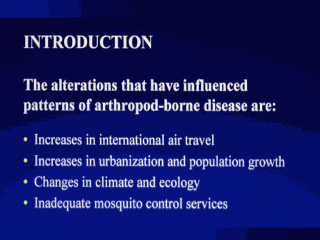Search inside of Supercourse and lectures in HTML and PPT format
|
|
|
|
front |1 |2 |3 |4 |5 |6 |7 |8 |9 |10 |11 |12 |13 |14 |15 |16 |17 |18 |19 |20 |21 |22 |23 |24 |25 |review |
 |
Human mobility and intervention also can be important for their role in introducing virus into susceptible populations. Increased air travel between urban centers of the tropics has been cited as a factor responsible for the increased frequency of dengue epidemics. The geographic dissemination and endemic maintenance of dengue in Mexico's border states depends on the continued introduction of virus into susceptible human populations, spread within these populations, and low-level transmission during non-epidemic periods. Continued dengue transmission represents a public health burden for Mexico, both in terms of costs of dengue control, as well as the potentially severe consequences of a dengue hemorrhagic fever epidemic. Resources for dengue control are limited, therefore identification of border areas that are at high risk of experiencing or disseminating dengue epidemics will lead to use of existing resources where they will have the greatest impact. The human population is growing exponentially, with virtually all of this growth occurring in urban zones. Compounding this problem, there is more population movement between urban centers within and among countries, more substandard housing, more artificial disposable containers and governmental services that are inadequate in these burgeoning urban centers. As a result of these changes, the resurgence of Aedes aegypti (dengue fever) is presently much greater than it has been in the past. Worldwide, up to 100 million people annually are infected with dengue fever, mainly in tropical cities and urban areas, while 2.5 billion people are at risk of infection. In most tropical countries of the world, it is difficult to determine how unhampered dengue prevention and/or control programs really are. Often, dengue (Aedes aegypti) control programs function as branches of malaria control programs and/or operate sporadically in response to real or perceived emergencies. Moreover, given the present economic crisis, very few countries have the resources to execute an effective eradication campaign. Consequently, these countries usually do not place a high priority on Aedes aegypti eradication programs since there are many other health projects that are considered more important and thus receive more resources. |